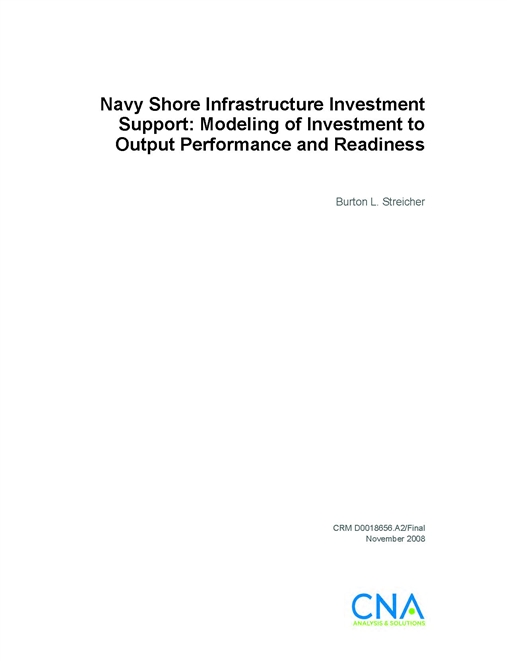Historically, the Navy has taken significant risk in shore infrastructure investment by diverting funds in order to increase afloat readiness and strengthen future platforms and weapons systems capabilities. This risk manifests itself over time through increased utilities outages, roof leaks, pavement potholes, and structural failures. In recent years, investment in the shore infrastructure has been further reduced in order to finance the Global War on Terrorism, homeland defense, theater security cooperation, humanitarian assistance, and peacekeeping operations.
As a result, the Navy suspects that the condition, capability, and current and future readiness of the shore infrastructure may have degraded. However, there is no consistent method for assessing the functional supporting levels of the shore infrastructure to determine the quantity of risk-burden being built up and amount of investment required to adjust this risk to acceptable levels.
CNA was tasked by the Director, Ashore Readiness Division (OPNAV N46) to develop a methodology for assessing infrastructure quality and readiness and to design a Shore Facility Investment Model (SFIM) to pull data from multiple sources [in Microsoft (MS) Excel and Access format] and combine them into an overall quality index rating. This rating system would be used as a decision support tool for Navy facility investment funds.
The development goals for the model were:
- To create a reliable system for acquiring and managing accurate, comprehensive, current, and integrated data on the condition, configuration, capacity, and operational status of all Navy facilities.
- To be output-based for quality assessment and able to balance infrastructure investments within the shore fund portfolio.
- To create a process that links force structure to infrastructure sites.
- To be a stand-alone assessment tool to aid in programming investment through analysis of future quality impact to inventory and shore readiness.
- To include a macro 20-year, long-range forecasting tool.
First, we analyzed the Navy infrastructure to determine the nature and quantity of the current inventory. The FY 2007 baseline inventory consists of 115,307 facilities with a plant replacement value (PRV) of $173,462 million. We segmented facilities in two ways in order to give Navy leadership a better overall idea of the inventory.
We used the traditional geographic and organizational view which maps each facility to one of 1,212 unique sites at 95 installations, within 14 regions or special interest areas. We also created a functional view that maps each facility to 1,117 facility category codes, organized under 80 shore function tasks, within 12 shore capability areas. This structure allowed us to index metrics together for Navy-wide functional assessments.
We also used five levels of mission dependency index or strategic sup- port index to categorize the risk importance of individual facilities, and we segmented the facilities by the 19 different maintenance fund- ing sources.
Download reportApproved for Public Release; Distribution Unlimited. Specific authority: N00014-05-D-0500.
Details
- Pages: 176
- Document Number: CRM D0018656.A2/Final
- Publication Date: 11/1/2008
